|
|
Post by Dave Homewood on Apr 7, 2018 0:00:14 GMT 12
|
|
|
|
Post by baz62 on Apr 7, 2018 12:20:28 GMT 12
Now replaced with a replica. Anyone know where the remains of NZ918 ended up?
|
|
|
|
Post by saratoga on Apr 7, 2018 15:21:45 GMT 12
I'm not sure if replica is the right description, maybe facsimile, in a cartoonish genre, might be more appropriate description.
It is however still yellow,so they got that right..ish.
|
|
|
|
Post by baz62 on Apr 8, 2018 14:12:12 GMT 12
Yes true an artist's representation might be the right term?
|
|
|
|
Post by Dave Homewood on May 12, 2018 15:49:50 GMT 12
With regard to paint schemes for Harvards, the following three drawings by G.D.Mansfield have appeared in Wings magazine. Of note is NZ927 in the second drawing where the first sentence of the comment reads: "NZ927, Gloss red overall, black antiddazzle panel, "27" and fuselage band blue." In the three photos that follow the drawings, I think that NZ903 is painted as NZ914 in the second drawing. The darkness of the yellow is because of the use of orthochromatic film as described by Shorty in Post 301 of this thread. However I suspect the photos of NZ923 and NZ927 were taken, probably using orthochromatic film, when they were actually painted red. Drawing 1 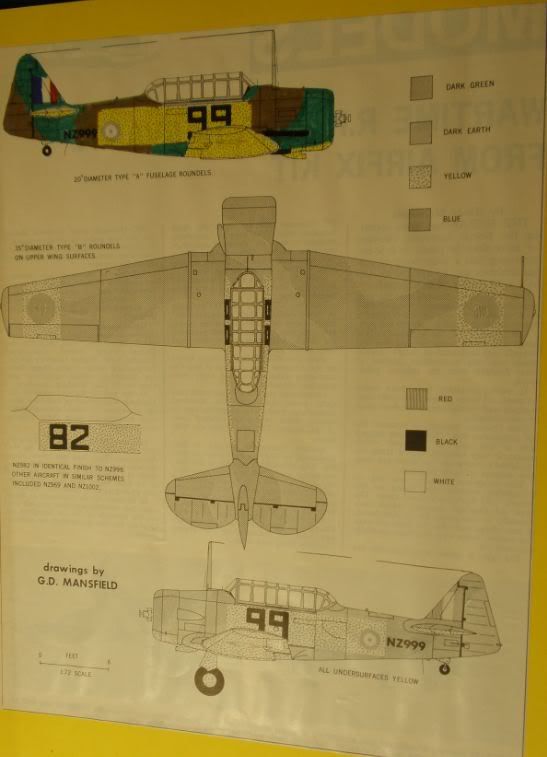 Drawing 2  Drawing 3 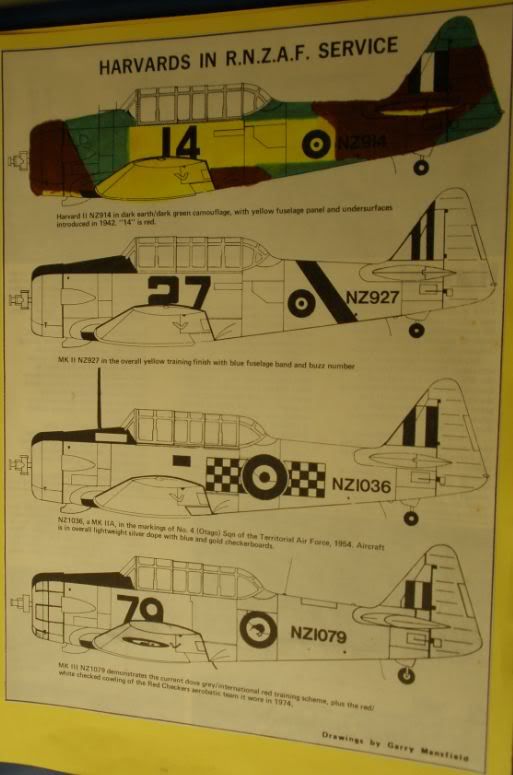 RNZAF or RNZAF Museum official: NZ903 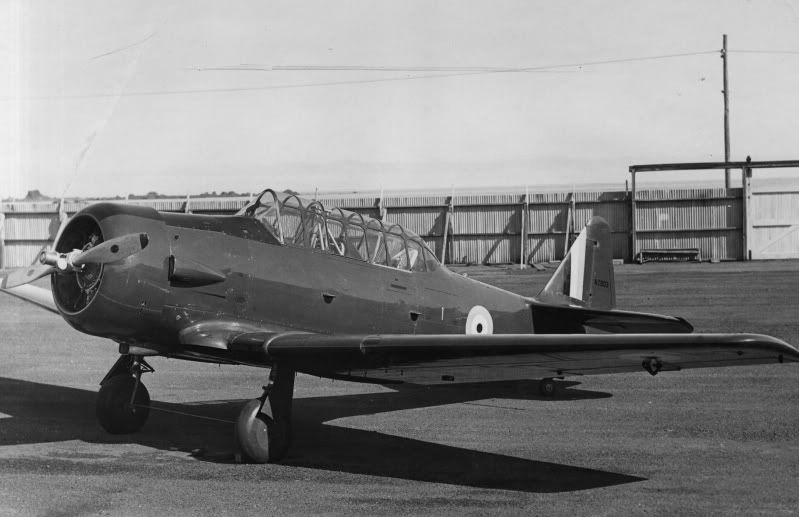 Photo first posted by Shorty NZ923 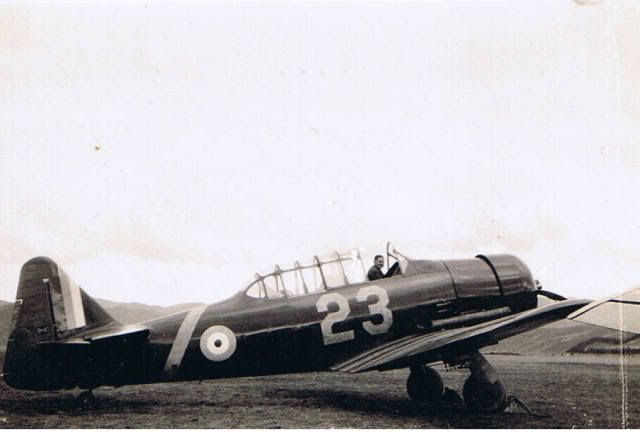 RNZAF or RNZAF Museum official: NZ927  I have been looking back through this fantastic thread and on rereading this post from Page 17 of the thread, I am wondering, if these two Harvards were in fact yellow, what colours were the buzz numbers on the sides? Because thy are not black on yellow, and if they were white on yellow, or Sky on yellow, they'd not be very visible. Is there any chance these two aircraft were genuinely gloss red, with withe or yellow or blue codes and band? The colour closely matches the red of the roundel centre. |
|
|
|
Post by camtech on May 12, 2018 16:17:35 GMT 12
If that was the case, Dave, then the fin flash colour would blend in, so I suspect the question is still not totally answered. Given the vagaries of film of the day, the possibilities are infinite.
|
|
|
|
Post by Dave Homewood on May 12, 2018 19:12:14 GMT 12
I wondered that too re the finflash but maybe it's a lighter red that the finflash red. Maybe it is somewhere between that and to International Oranga
|
|
|
|
Post by planewriting on Dec 4, 2018 22:12:48 GMT 12
Never assume anything – Tripped over the following in the Aviation Historical Society Journal December 1972 published 46 years ago.
THE HARVARDS RETURN TO WOODBOURNE BY R E Montgomery.
RNZAF Base Woodbourne, war-time home of more than 60 Harvard single-engined trainers, now has eight of these aircraft permanently based there. But they won't be flying; in fact the Harvards will probably never leave the big hangar in which they are housed.
The Harvards were brought by road from Wigram where they had been in storage for some time. Each aircraft had clocked up approximately 1,500 hours in various war-time and post-war training duties. Their main purpose at Woodbourne is to provide spares for Harvards still in service – a kind of metallic Christmas tree.
The aircraft still wear the silver/yellow trainer scheme in which they last flew. Aircraft at Woodbourne are Mk IIAs NZ1034, 1038, 1040, 1050, 1051, 1052, 1053 and 1057. The first to arrive at Woodbourne was NZ1053, late in the afternoon of 23 August 1972. My thanks are due to Wing Commander N H McDonald BEM, OC No 1 Repair Depot, and the personnel of the Tech. Control and Planning Centre.
SO – where to?
NZ1034, 1038, 1040 and 1051 all went to Australia. NZ1050 is up the pole at Wigram serving as a Gate Guardian and NZ1052, NZ1053 and NZ1057 form part of the Ardmore based Roaring 40s team. Another interesting point - they had each logged about 1500 hours back in 1972. Some of them have been flown on a very regular basis in their new lease on life; I wonder what sort of TTAF they have now accumulated.
|
|
|
|
Post by Dave Homewood on Dec 4, 2018 23:21:05 GMT 12
Interesting, I honestly thought they'd have accumulated a lot more time than that in 30 years of service, even if it was not quite continuous service. It would be very interesting to know what some of these aeroplanes' hours are now, for sure.
|
|
|
|
Post by 185skywagon on Jan 4, 2019 19:27:37 GMT 12
Was going through some photos from John Smiths collection. I can see two harvards but in particular one has a coat of arms on the tail, over orange. Was wondering if anyone knows what aircraft this might be ? ADF serials notes two machines there - 909 and 1068. Can't have imagined 909 with orange but can't find any pictures of 1068 with a coat of arms.
|
|
|
|
Post by davidd on Jan 5, 2019 11:13:38 GMT 12
Because the RNZAF had so many Harvards "on the books" postwar, only a small proportion were ever in use at any one time, so flying hours were accumulated fairly slowly, even among the active ones. However even wartime utilisation was not that great, as these figures (taken from the log book of NZ1003, a genuine Mk. II, built in 1941) reveal. This aircraft, numbered with RAF serial AJ890, complete with P&W S3H1 Wasp engine No. 11529 (A.213800, Air Ministry) fitted on 9/10/41, despatched in crated condition on 13/10/41 to the Honourable Minister of Defence, Auckland, NZ. (Signed by E Weiser, inspector in charge, BAC, NAA Inglewood, California.) Same aircraft received at No. 1 A/C Depot, Hobsonville, 6/2/42, unpacked and inspected in accordance with ARS Schedule. Airscrew 63921 fitted. Aircraft renumbered NZ1003 in accordance with Air HQ Instructions, signed by A T Giles, O/C Assembly Flight, RNZAF Base Auckland. (Question: who thought it was called RNZAF Station Hobsonville in those days?) NZ1003 test flown 20/2/42 for 35 minutes by A E Willis. Another 2 H, 30 mins flown off 20 - 22/2/42, then aircraft delivered to Central Flying School, Tauranga 23/2/42, in accordance with AHQ Allotment No. 1201. Total hours flown between 23 - 28/2/42 came to 17 H, 5 mins. Subsequent monthly flying hours listed as follows:
1942 (from March to December): 55.45, 19.45, 24.25, 36.35, 21.50, 50.30, 34.45, 61.05, 15.25, (December nil, not explained); Total hours to date: 340.15.
1943 (Jan to Dec): 30.55, 18.00, 58.35, 38.25, 64.15, 60.45, 93.50 (apparently a very busy month), 15.10 (had first engine change this month, carried out by 3 RD, Harewood), 26.35, 63.40, 49.55, 70.40. Hours for year, 590.45, accumulated hours, 931.00.
1944 (Jan to Dec): 66.05, 73.35, 59.25, 66.15, 69.20, 107.50 (a new monthly record), 94.70, 134.15 (another record high!), nil hours during September (major airframe overhaul @ ARS, 2 SFTS Woodbourne), then 40.05, 50.25, 48.50, 40.20: Hours for year, 851.35, accumulated hours, 1,782.35. Special Note: Monthly flying hour calculation changed from September 1944 onwards, to a new and more complicated one which no longer followed this format, thus 13 months shown. Still, the monthly and annual totals are approximately correct.
1945 (Jan till 13th June only): 87.20, 92.40, 41.45, 91.55, 50.05, 41.00: Hours for year, 404.45, accumulated hours, 2,187.20. And this seems to be the entire flying history of this aircraft. Note that there is no indication that this Harvard was ever test flown in the USA. Apart from the original engine fitting, three other engines were fitted, one of these twice in succession. Original inspection regime was in format of daily, 30 hour inspections, 240 hour overhauls; changed in April 1943 to daily, 40 and 80 hr inspections, and 320 hour overhauls; changed again (February 1944) to daily, 45 and 90 hour inspections, 360 hour overhauls. Main flying units during this aircraft's history were CFS (Tauranga) Feb 42 to 4 Sept 44; with 1 SFTS (Wigram) 15 Oct 44 to June 1945, including a major overhaul and engine change from 7 - 19/3/45.
David D
|
|
|
|
Post by davidd on Jan 5, 2019 11:51:09 GMT 12
Some (any?) members might find the following Harvard utilisation figures and associated comments for the FTS (Wigram) for period 27/2 - 25/3/52 of some interest (from DTS Flying Period Report, dated 22/5/52).
Paragraph 6: Wigram. "Serviceability of Harvards has been 62% for 954 flying hours. This gives utilisation of over 50 hours for each of the 19 aircraft. This is commendable."
The following two monthly reports (actually "Flying Periods" of 28 days) state that Wigram Harvard serviceability was maintained at 66%, and this gave a "very good" utilisation of 51 hours per aircraft. The two Devons (new in service) were flown at the rate of 25 hours per aircraft. The June/July reporting period was very similar, with serviceability at 65% for both periods, with an average utilisation of 39 hours per aircraft. By this time, the number of Harvards held by Wigram had grown to 22, with a required task of 1,015 hours, of which 841.25 achieved. Average Harvard serviceability over period was 14.65.
The Sept/October 1952 report (two flying periods of 28 days) seemed to indicate increasing serviceability of the Harvards, with an average of 70%, and utilisation of 62 hours per aircraft. Flying hours achieved by average of 18.95 serviceable aircraft out of 26.35 held, for the 2 periods was 1,529.05 day and 104.50 night hours, for a total of 1633.55 hours.
I think this gives an interesting comparison with the wartime monthly figures for NZ1003 in previous post. You might gather that the individuals tasked with working out these utilisation and serviceability figures had to have a keen mind and very sharp pencils, and not be put off too easily by lots of multiplication and long division with decimal points to two places. Very boring to read until you get the hang of it, then just slightly less boring.
David D
|
|
|
|
Post by johnnyfalcon on Jan 5, 2019 13:19:27 GMT 12
Good grief David! Did you get a holiday??
|
|
|
|
Post by davidd on Jan 5, 2019 16:36:34 GMT 12
johnnyfalcon,
Sadly, no!
|
|
|
|
Post by johnnyfalcon on Jan 5, 2019 17:16:00 GMT 12
So it would appear!
|
|
|
|
Post by denysjones on Apr 30, 2019 10:16:26 GMT 12
One of the Ferrymead team alerted me to this which may be of interest following on from the recent discussions here. link |
|
|
|
Post by htbrst on Apr 30, 2019 10:34:08 GMT 12
One of the Ferrymead team alerted me to this which may be of interest following on from the recent discussions here. linkThe date published is April First unfortunately  |
|
|
|
Post by shorty on Apr 30, 2019 12:49:16 GMT 12
Quote:-
Comparing my photo and the Museum photo taken at Rongotai, if you use the roundel colours as your reference the buzz numbers would seem to be blue, giving us yellow overall with blue buzz number
|
|
|
|
Post by tbf25o4 on Apr 30, 2019 15:47:55 GMT 12
The appearance of what seems to be dark colours in those early black and white photographs comes from the processing used in those days. Shorty is correct in that the overall colour was the yellow, with
the "buzz" number being blue
|
|
mgr
Leading Aircraftman

Posts: 8
|
Post by mgr on Jun 2, 2019 5:43:00 GMT 12
Hiya, Forgive me if posted before, came across this picture, notice the cammo Harvard in the right corner. Coded JZ-Y 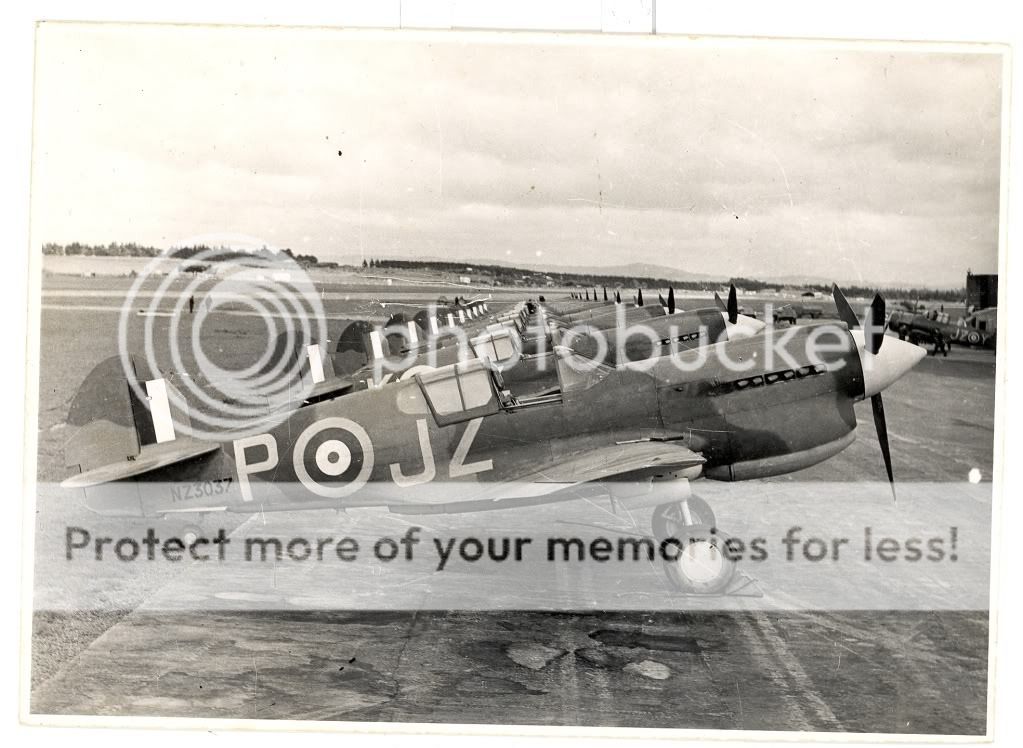 Marcel |
|



